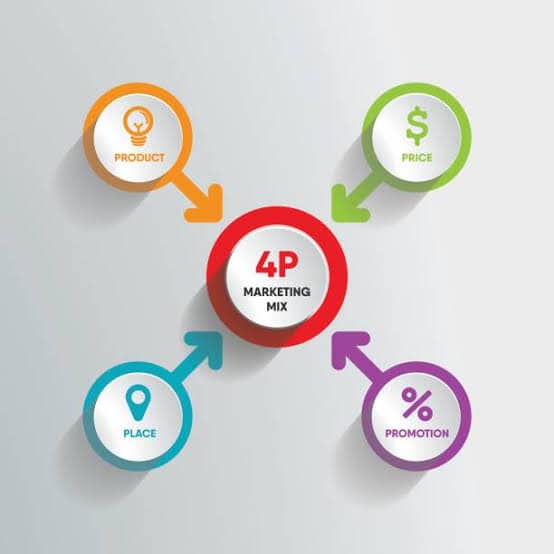“In the world of marketing, the terms ‘4Ps’ or ‘Marketing Mix’ are frequently used. These elements are crucial when devising strategies to introduce products or services to the market and offer them to customers. This article aims to provide detailed explanations of what the 4Ps are and why they are essential in the digital era.
Recommended Read: ‘Understanding All about Marketing Strategies! Explaining Strategies and Methods from the Basics’
Let’s dive into the realm of marketing strategies, dissecting the fundamental components of the 4Ps and exploring their significance, especially in today’s digital landscape.”
1.What are the 4Ps (Marketing Mix)?
The term ‘4Ps’ refers to the Marketing Mix, which comprises four fundamental elements: Product, Price, Promotion, and Digital Place. These elements constitute a framework to consider when constructing marketing strategies. Let’s delve into how each element contributes and how they are applied in the digital era.
The Importance of Marketing Mix
The Marketing Mix serves as a framework for planning how products or services are positioned and offered in the market. In today’s fiercely competitive business landscape, designing and executing an appropriate Marketing Mix is incredibly crucial. Let’s explore each of the 4P elements in detail.
2.Details of the 4P Elements
The Role and Evolution of Products (Product)
In the digital era, the role of products has undergone significant changes. Digital products and services have emerged alongside physical goods, transforming customers’ lives. Let’s delve into the strategies for offering digital products and services and how they impact customers.
Rise of Digital Products
Digital products encompass computer software, e-books, music streaming, cloud-based services, among others, lacking a physical form. These goods are delivered through digital distribution methods like downloads, streaming, or subscriptions, allowing customers to enjoy valuable experiences without purchasing physical items.
Digital Transformation and Products
Many companies are undergoing digital transformations by digitizing traditional physical products. For instance, advancements in autonomous driving technologies are positioning automobiles themselves as digital platforms. Understanding such shifts is essential for adjusting product strategies.
Application of Pricing Strategy (Price) to the Digital Realm
Pricing directly affects a company’s revenue and competitiveness. In the digital market, pricing has become more complex, intensifying competition. We’ll focus on the concept of digital pricing strategies and approaches to pricing in the digital era, showcasing successful examples.
Dynamic Pricing
Dynamic pricing involves adjusting prices based on demand and supply. In the digital market, real-time data analysis allows for optimizing prices. Platforms like airline or accommodation booking sites use this strategy, raising prices during peak times and lowering them during low-demand periods.
Subscription Models
In the digital era, many companies adopt subscription models. Customers pay monthly or yearly fees to access services. This model ensures stable revenue and fosters long-term customer relationships.
Facing the complexity of pricing and fierce competition, companies need to strategically consider digital pricing strategies and set prices based on customer value.
3.Integration of Digital Marketing with the 4Ps

Digitalization of Promotion Strategy (Promotion)
Digital marketing introduces new advertising channels and tools, enabling the digitalization of promotion strategies. We’ll explore digital promotions’ fundamentals, such as digital advertising, social media marketing, and effective implementation methods.
Social Media Advertising
Social media facilitates direct interaction between advertisers and customers, enhancing targeted advertising accuracy. Platforms like Facebook, Instagram, or Twitter display ads based on user interests and actions, providing real-time feedback to advertisers.
Content Marketing
Content marketing emerges as a critical component of digital promotion strategies. Through blog posts, video content, podcasts, companies provide valuable information to customers, building trust and expertise. Engaging content attracts customer interest and boosts brand loyalty.
Significance of Digital Place (Place) Strategy and Omnichannel Approach
The digital place strategy focuses on how products or services are delivered to customers. The omnichannel strategy allows customers access to products through multiple channels. We’ll explain the importance of digital place strategy and the omnichannel strategy, accompanied by successful examples.
Integration of Online Stores and Physical Outlets
Many brands seamlessly integrate online stores and physical outlets, offering customers a flexible shopping experience. Customers research products online and make purchases or try items in physical stores. This integrated approach provides choices tailored to customers’ needs, enhancing the purchasing experience.
Mobile Shopping and Convenient Payment Methods
With the proliferation of smartphones, mobile shopping is rapidly growing. Customers can purchase products anytime, anywhere through mobile applications. Moreover, new payment methods like digital wallets or QR code payments streamline the purchasing process.
Implementing effective digital place and omnichannel strategies enhances customer convenience and strengthens relationships with brands. These strategies are key to differentiation in the fiercely competitive digital market.
4. Case Studies and Analysis of the 4P Strategy
Role of Analysis and Data-Driven Approach
Data analysis is a crucial tool for evaluating and enhancing the 4P strategy. In the digital era, vast data availability becomes key to establishing competitive advantages. Let’s explore the basics of data-driven approaches and their effectiveness through success stories.
Cloud-Based Data Analytics Tools
Cloud-based data analytics tools are invaluable assets for businesses. These tools collect, organize, and analyze massive amounts of data, providing business intelligence. Real-time data dashboards and predictive analytics offer essential insights for strategy optimization.
A/B Testing and Optimization
A/B testing involves comparing different versions of web pages, ads, or content to identify the most effective one. In the digital environment, real-time testing and optimization are feasible. Data-driven decision-making allows continuous improvement of the 4P strategy, maximizing results.
5.Implementation of 3C Analysis and Optimization of the 4P Strategy

Understanding Customer Needs
Effective methods like surveys, feedback collection, usability tests help understand customer needs. Listening to customer voices facilitates product or service improvements. Additionally, deploying strategies tailored to different customer segments through customer segmentation is vital.
Competitive Analysis
Competitive analysis evaluates competitors’ strategies and performance to understand one’s position in the market. Investigating competitors’ products, pricing strategies, and promotional activities identifies their strengths and weaknesses. Use this information to devise differentiation strategies.
Leveraging Company Strengths
Leveraging company strengths is indispensable for the success of the 4P strategy. This involves maximizing the company’s unique features, technology, and brand value. Emphasize the value addition provided to customers and differentiate from competitors.
6.Utilization of the 4P Strategy Template
Creating an Effective 4P Strategy Template
An effective 4P strategy template is a valuable tool for planning and executing strategies concretely. We’ll explain the steps for creating a 4P template and detailed designing of each element.
Product
Describe product features, benefits, and competitive advantages in detail. Consider the value customers find in the product and emphasize its unique features.
Price
Plan pricing strategies, discounts, pricing models considering comparisons with competitors and market trends to set appropriate prices.
Promotion
Organize advertising strategies, promotional campaigns, and digital marketing strategies. Plan specific tactics to reach the target audience.
Place
Consider sales channels, distribution strategies, and omnichannel integration. Clearly define how customers access products or services.
Tips and Considerations for Applying to Business
Points to consider while applying the 4P strategy template to business are crucial. We’ll explain key tips and considerations for success.
Flexibility
The 4P strategy should have the flexibility to adapt to changes. Adjust strategies to respond to market shifts and competitor movements. Given the fast-paced digital environment, an agile approach is effective.
Data Utilization
Utilize data analysis to regularly evaluate and improve the effectiveness of the 4P strategy. Data-driven decision-making is a shortcut to success.
Customer-Centric Approach
Utilize the 4P elements to enhance the customer experience. Meeting customer needs and expectations is the secret to gaining a competitive edge.
7.Conclusion and Future Outlook
4P Strategy’s Continued Relevance in the Digital Age
Even in the digital age, the 4P strategy remains fundamental in marketing strategies. Adjusting the 4P strategy appropriately with the evolution of digital technologies is crucial to sustaining competitiveness and ensuring business success.
Future Outlook
Factors such as the evolution of AI, data analytics, and environmental considerations will influence the 4P strategy. Companies need to incorporate these factors to build sustainable marketing strategies. While the 4P strategy evolves, its fundamental principles continue to play a crucial role as guiding principles towards success.




